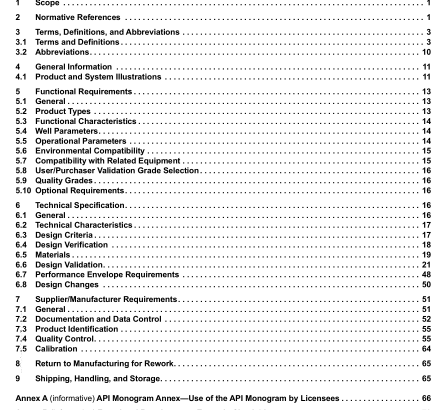API SPEC 19LH:2019 pdf free download.Liner Hanger Equipment
6.4 Design Verification
6.4.1 General Design verification shall be performed using documented procedures to ensure that each product/system design meets the supplier/manufacturer’s technical specifications and shall include activities such as design reviews, design calculations, physical tests, comparison with similar designs and historical records of defined operating conditions. Verification results shall be reviewed and approved by a qualified person and records of the review shall become a portion of the design documentation (see 7.2).
6.4.2 Design Analysis
6.4.2.1 General The equipment shall be analyzed to determine the performance limits. The performance limits of the assembly shall be determined by the component of the design with the highest stress factor (or strain factor for plastically deformed components).
The design shall consider all operational loading conditions defined in the functional specification. One of the design analysis methods in 6.4.2.2 shall be used to determine the maximum state of stress of a component. Once the method is selected, it becomes the requirement.
The supplier/manufacturer shall identify the Type 1 components of the product or system and the mode of loading. The supplier/manufacturer shall calculate the stress level (and strain level for plastically deformed components) in the identified component(s) based upon the worst-case loads in the design requirements. In the determination of ratings, the minimum acceptable material condition and minimum acceptable material yield shall be used in the calculations.
The calculations shall include consideration of the effects of temperature. Tests by the supplier/manufacturer shall be conducted in accordance with ASTM E21 or ISO 6892-2 for yield strength and ASTM E111 for modulus of elasticity. Other equivalent national or international standards may be used. Metal mechanical properties derating shall be in accordance with one or more of the following:
— industry recognized published data reviewed and verified by a qualified person;
— data provided by the material supplier;
— data used by the supplier/manufacturer.
6.4.2.2 Design Analysis Methods
6.4.2.2.1 Distortion Energy Theory The distortion energy theory, also known as the von Mises yield criterion, may be used for design calculations for pressure-containing components.
NOTE The distortion energy theory predicts a combined stress that will exceed the material’s minimum yield strength; this is also commonly known as von Mises stress. This theory determines a combined stress at a point from the given principal stresses. The von Mises stress predicts failure when the total amount of distortion in a differential cube of material is equivalent to the distortion experienced by the same cube when loaded by a uniaxial force to the yield point.
6.4.2.2.2 Triaxial Yield and Collapse Equations
API 5C3 provides equations that may be used to derive the triaxial yield and collapse of a cylinder.
6.4.2.2.3 Finite Element Analysis
Finite element analysis (FEA) is a design verification methodology that may be used to predict equipment performance for complex geometry and/or complex loading where conventional verification methodologies are considered incomplete by the design engineer.
NOTE An example FEA method for analyzing a pressure-containing component is described in Annex D.
6.4.2.2.4 Supplier/Manufacturer Defined Analysis
Supplier/manufacturer defined analysis may be used for design calculations for pressure-containing components.
6.4.3 Rated Performance Envelope
A rated performance envelope as specified in 6.7 shall be prepared for systems validated to VS1 or VS2.
For validation grade VS3, a rated performance envelope shall be prepared when requested in the functional specification.
6.5 Materials
6.5.1 General Materials for each component shall be stated by the supplier/manufacturer and shall be suitable for the environmental conditions specified in the functional specification. The supplier/manufacturer shall have documented specifications for all materials, and materials shall comply with these specifications.
a) The user/purchaser may specify materials for the specific use and corrosion environment in the functional specification. If the supplier/manufacturer proposes to use another material, the user/purchaser has the option to accept or reject the proposed material alternative. This applies to metallic and nonmetallic components.API SPEC 19LH pdf download.API SPEC 19LH:2019 pdf free download
